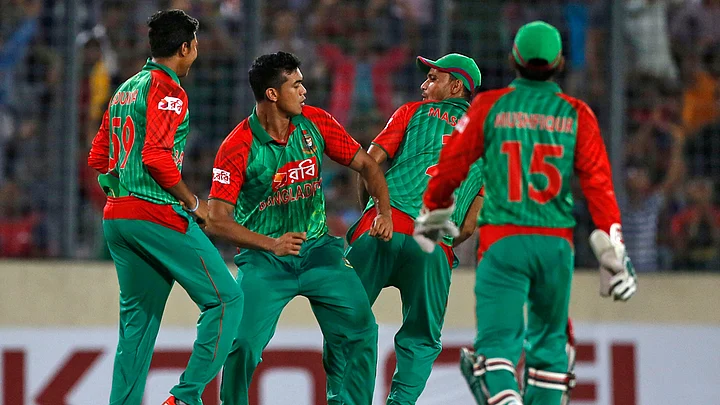Till Sunday, June 21, few people in the subcontinent, let alone globally, knew who Mashrafe Mortaza was.
The buzz that morning was all about yoga, and how the whole world, led by Prime Minister Narendra Modi, was going to celebrate it. After all, the UN had declared June 21 as World Yoga Day.
Apart from yoga, which India is supposed to have exported to the rest of the world, there’s something else we’re supposed to have conceived: the idea of Zero. Ideally, next year the UN should declare June 21 as World Zero Day as well.
Because that’s the day when a three-match cricket one day international (ODI) series between India and Bangladesh ended 0-2 in favour of the latter, ending the contest. Leading that team was Mortaza, who’s inked his and his teammates’ names, in the subcontinent’s cricket history.
After all, of the 10 teams that qualify to play ODIs by the International Cricket Council (ICC), Bangladesh ranks 9. In contrast, India has won the ODI World Cup twice, in 1983 and 2011, and been semi-finalists thrice more.
Besides, India is the world’s largest sponsor of this game, has the largest fan following and has huge clout in international cricket. Our players are a pampered lot, surrounded by starlets, swamped by sponsor rupees.
Given all that, it’s time to give a standing ovation to the talented, young – and largely unheralded – Bangladesh team that brought us crashing down to Earth. All the sins of our cricket administration – its bounty, bullying, arrogance and graft – have come to bite us in our posterior.
If you’re a sincere cricket fan, give gaalis to the overrated Mahendra Singh Dhoni and his band of puffed-up underachievers.
But reserve the chappals for LaMo, NSri, ShaPa, AruJa and all the other greedy bloodsuckers who run the game in India.
Ask any of these fellows to take a shortish run-up like Kapil Dev used to do and bowl a couple of overs, medium pace, non-stop, in the heat of June. If anyone survives a cardiac arrest, they can run Indian cricket.
But enough. Think about the many subtexts to this tale.
Breaking The Stereotype
One, it demolishes the stereotype of the Bengali as an effete, rice-and-fish eating sedentary type, good only as clerks, salarymen or rent-sucking landlords. And of course, no good at sport.
This artifice was created by the British after the 1857 Uprising when they grew suspicious about Bengal’s loyalty to Empire and thought up this theory to exclude Bengalis – and Muslims – from military service. In a way, June 21 exposed this as bunkum.
Two, Bangladesh’s performances – two ODI wins in a row over India and 10 successive wins at home – support a hypothesis of empirical economists. They argue that a nation’s sporting successes follow growth and improvements in economic, political and social conditions.
So, kids who eat well, get lots of exercise, institutional and income support early in life, are likely to become good athletes later on. Look no further than the US or Europe.
On the other hand, if you’re malnourished, and your options are to peddle trinkets on the road, run around as the chhotu serving samosas at a dhaba – or beg on the roadside – your chances of winning an Olympic medal drop substantially.
Bangladesh’s Economic Triumph
But barring extremely unfortunate circumstances, countries will converge – or catch up – with each other economically. This is a prediction that’s proved mostly correct as Japan, South East Asia and China grew and prospered after WW-II.
As they did, their sporting performances improved: today Japanese, stereotyped as ‘midgets’ in an earlier era, play in America’s pro-basketball NBA league. China hauls up Olympic medals by the armful after 35 years of uninterrupted state-led growth.
We weren’t looking, but Bangladesh’s triumph should come as no surprise. Once regarded as a basket case, Dhaka has quietly pulled itself up by its bootstraps economically. During five years from 2010-14, its economy grew on average 6% per year. This was driven by exports, huge increases in farm productivity and relative political stability under the Awami League regime. By 2017, growth is projected at 6.6%.
Nobel laureate Amartya Sen pointed this out a few years ago, when he said:
In terms of many typical indicators of living standards, Bangladesh not only does better than India, it has considerable lead over it.
— Amartya Sen, Nobel laureate
One overall measure of well-being is life expectancy at birth (LEB). LEB tells us how many years a person born today will survive; because this depends on many factors like income, nutrition, healthcare and so on, it’s a catch-all for a nation’s progress.
Bangladesh now has a LEB of 71 years; this is higher than the South Asian average of 67, and more than India’s 66 years.
So, Bangladesh has thrashed India in cricket. Could they have beaten us in development as well?
(The writer is a senior journalist based in Delhi.)
(At The Quint, we question everything. Play an active role in shaping our journalism by becoming a member today.)
